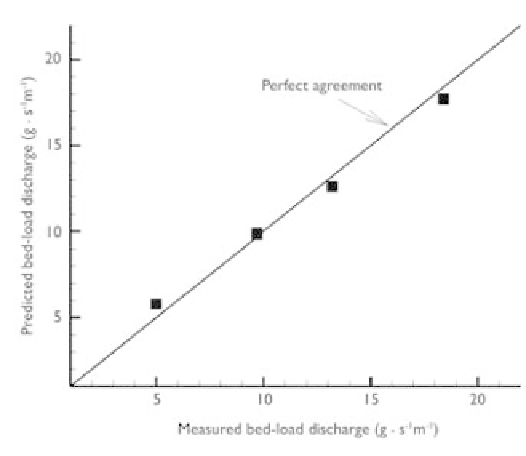Geoscience Reference
In-Depth Information
Wu
et al
. (2005) applied the formula of Wu
et al
. (2000b) to compute the bed load
in vegetated channels, with the effective bed shear stress
τ
b
determined by
τ
=
γ
R
s
S
(10.36)
b
where
S
is the channel slope; and
R
s
is the hydraulic radius, defined in Eq. (10.17), as
suggested by Barfield
et al
. (1979). The computed values of bed-load transport rate
were compared with the measured data (Series A,
q
0.0065 m
2
s
−
1
) of Jordanova
and James (2003), as shown in Fig.10.8. An excellent agreement was observed.
=
Figure 10.8
Measured and predicted bed-load rates in a vegetated flume.
Okabe
et al
. (1997) investigated the bed-load transport in a flume covered by
submerged vegetation. They modeled the vegetation using curved, cylindrical silicone
tubes and branched, inclined brass lines. They used a vertical 1-D
k
-
turbulent flow
model to determine the effective bed shear stress and applied the formula of Ashida and
Michiue (1972) for the bed-load transport rate in vegetated channels. The agreement
between the measured and predicted values was generally good.
It can be seen fromOkabe
et al
. (1997) and Wu
et al
. (2005) that bed-load transport
is mainly related to bed shear rather than the drag force exerted on vegetation elements.
If the effective bed shear is used, some existing bed-load formulas developed for non-
vegetated channels can be extended to the case of vegetated channels.
However, the suspended-load transport in vegetated channels has been little investi-
gated. Because vegetation may reduce the mean flow velocity significantly but intensify
the turbulence in a vegetated zone, the effect of vegetation on suspended-load transport
is more complex. More experimental and theoretical studies are needed to quantify this
effect. As an approximation, one may apply some existing suspended load formulas
ε

